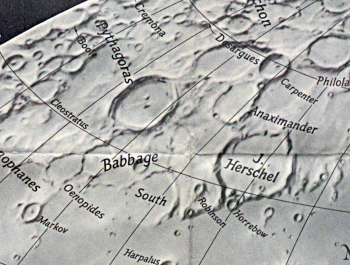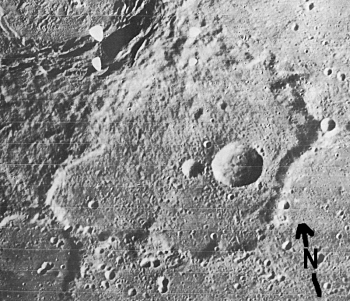Dave Mitsky and Tony Donnangelo have sent the following observation report,
concerning the sighting of a lunar ray within the crater Babbage:
Observers: Dave Mitsky and Tony Donnangelo Date/time of observation: 2002/2/25 ~02:00 UT Location of site: Hummelstown RD 3, PA, USA (40.26° N., 76.75° W.) Site Elevation: 425 feet (129 meters) Site classification: Suburban Sky darkness: Moon was 93% illuminated Seeing: 8 <1-10 Seeing Scale (10 best)> Instrument: Takahashi FS-102 Magnification: 102.5x, 205x, 394x Object: Babbage (Crater), Rukl Chart #2 Lunar Light Rayís Coordinates: 59.5°N., 53°W. We noticed a lunar sunrise ray in the southeast corner of Babbage, along the wall next to the crater South. The ray was a moderately broad pie-shaped swath of light that illuminated the crater floor, which was not totally in darkness at the time. On Ruklís Chart #2, you can see a peak with two V-shaped notches in the wall of the crater. The V-shaped notches were illuminated by sunlight when first noted. The ray was caused by the more eastern notch. It might be possible to see the ray at an earlier hour. We observed the ray until 04:30 UT. It was probably still visible until well after that time. Dave Mitsky Tony Donnangelo
Using Dave and Tony's location coordinates, and times reported, the follow initial set of predictions were generated:
Starting Date = 2002 / 1 / 1 U.T.
Site Longitude = 76.75 Latitude = 40.25 Elevation = 129 meters
Feature = BABBAGE
Longitude = -56°48' Latitude = 59°30'
Reproducing Lighting For: 2002 / 2 / 25 at 2 : 0 UT
Desired Solar altitude = 2.053° (Rising), Azimuth = 96.320°
Average Co-longitude = 60.847
In the time column, D=daylight, T=twilight
---- Moon's ----
Topocentric -- Earth's -- ------- Sun's -------
UT Date Time Alt° Semi-diam" long° lat° colong° lat° azim°
2002/ 2/25 1:59 65.89 1000.24 -5.69 -4.15 63.28 -1.43 96.31
===============================================================================
This showed the desired observing time, would be with a co-longitude of 60.847 and the solar altitude of 2.053 rising.From these parameters, the predictions for future events were generated.
Crater Description:
Babbage, -430,+860 - This is not a true crater, but is due to a fusion of two large rings. South of the centre of the southern component is a deep crater, A, with a smaller to the north-east, from which a slight ridge runs south-east, and is sometimes to be seen as a bright line amid the shadow. On the south crest is a row of little peaks, some craterlets on the outer slope and a partial ring, S. This is really on the floor of South, the formation adjoining Babbage on the south. The east wall is tolerably high. The northern component contains some ridges and small craters. Pythagoras lies close to the north-west, and was much displaced by Goodacre. North is the ring F and on the mean libration limb a double formation, A and E. - (Wilkins and Moore, The Moon, Faber & Faber, 1955)

